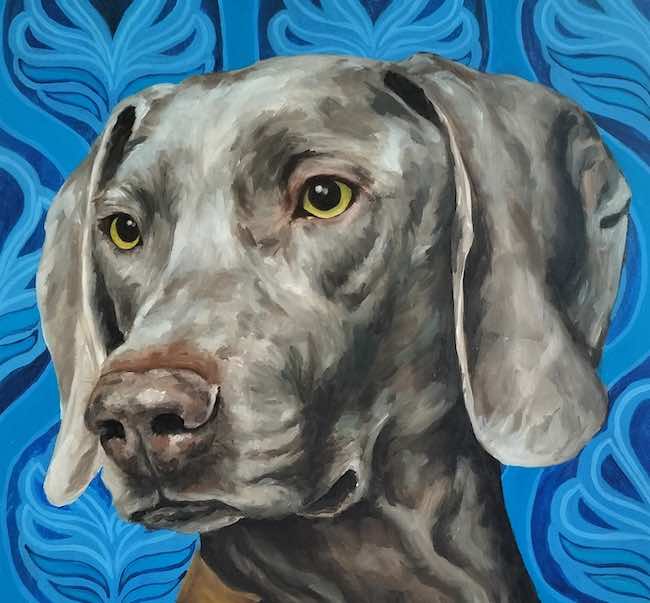L’arte contemporanea si pone come mezzo di superamento dei limiti e dei confini che avevano contraddistinto gli stili dei secoli precedenti ma anche come espressione di una società in evoluzione che necessita di esprimere e sottolineare valori e tendenze nuove per le quali la creatività diviene una voce intensa e personale, simbolo dei nuovi concetti e di un inedito approccio nei confronti della vita e di tutto ciò che ne fa parte. L’artista di cui vi racconterò oggi non può fare a meno di lasciar emergere il suo grande amore per il mondo animale attraverso uno stile fresco e divertente, in cui associa il talento di un tratto classico a sfondi colorati e vivaci.
Nel corso di tutta la storia dell’arte il mondo animale ha sempre rivestito un ruolo importante poiché fin dai tempi dei ritratti nobiliari, cani e gatti sono stati immortalati con i loro padroni come se costituissero una parte importante della famiglia; il cane in particolar modo è stato protagonista di opere di alcuni tra i maggiori maestri del Quattrocento, come Tiziano che nel suo Ritratto di Carlo V esaltò il rapporto tra il sovrano e il suo animale domestico. Nel Seicento un il grande pittore fiammingo Frans Snyders dedicò parte della sua produzione artistica a ritrarre animali, in particolar modo i cani o le scene di caccia, mettendone in evidenza le espressioni e particolareggiandone i dettagli del pelo. Malgrado in quel periodo la presenza di animali nelle opere d’arte fosse correlata all’uomo definendone la possibilità economica di poterne avere la presenza in casa, vi furono dunque esempi di maestri che resero protagonisti assoluti di tele di grande impatto cani, cavalli, uccelli; la Testa di cervo di Velázquez è un esempio di vero e proprio ritratto in cui il mondo animale è al centro della scena e il cervo sembra consapevole di essere immortalato, mostrando un’espressione quasi umana. Con il susseguirsi dei secoli e l’avvicinarsi al Novecento, molti artisti interpretarono, ciascuno attraverso il proprio personale stile, il mondo animale, da Cassius Marcellus Coolidge che nella sua celebre opera A friend in need immaginò un tavolo da pocker in cui i giocatori erano cani di diverse razze e i cui comportamenti e atteggiamenti erano perfettamente conformi a quelli degli umani, passando per la stilizzazione divertente e colorata di Keith Haring il cui cane abbaiante è strettamente legato nell’immaginario comune all’artista stesso, fino ad arrivare a David Hockney il cui amore per i suoi due bassotti lo condusse non solo a dedicare loro moltissimi ritratti ma anche a raccogliere questa sua produzione artistica in un intero volume dal titolo Dog Days, andando contro corrente rispetto ai soggetti in voga negli anni Novanta, quando in particolar modo negli Stati Uniti il Realismo si stava orientando alla rappresentazione delle scene di vita metropolitana o dei sobborghi come esaltazione della bellezza delle città ma anche della solitudine dell’essere umano. E non si può parlare di cani senza citare Jeff Koons che proprio a questo animale deve il suo successo planetario. Nell’era contemporanea sono sempre più numerose le persone che accolgono un cucciolo in casa fino a farlo diventare un vero e proprio elemento fondamentale della stessa famiglia, oppure per alleviare la loro solitudine emotiva, e dunque gli artisti che si sentono affini alle medesime emozioni scelgono proprio questo genere pittorico per esprimere la loro creatività; dalle opere su commissione a quelle che invece scaturiscono dalla creatività, il ritratto dei migliori amici dell’uomo è divenuto un vero e proprio genere pittorico.
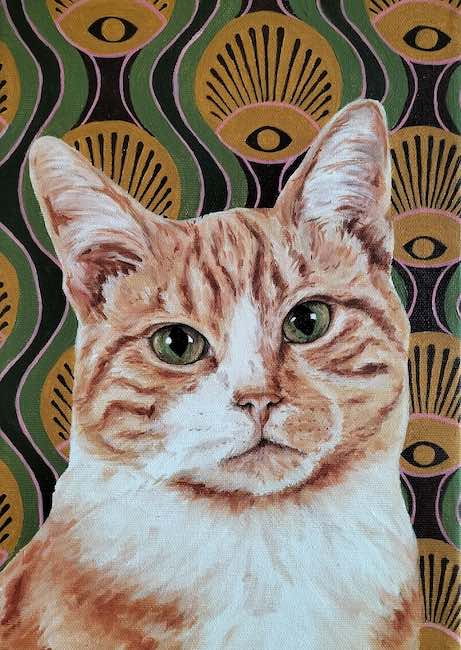
L’artista bolognese Carlotta Marvasi sceglie però di non fermarsi alla rappresentazione Iperrealista dei volti di cani, gatti, cavalli bensì approfondisce la tematica introducendo un tocco personale che rende le sue opere uniche, divertenti e originali con una forte impronta Pop che si mescola al talento dell’Iperrealismo in virtù del quale sottolinea i dettagli focalizzando tutto il fulcro della tela sugli sguardi, più vivaci, più teneri, più curiosi o distratti in base alla personalità dell’animale che sta ritraendo. Gli sfondi Art Decò si armonizzano con l’atmosfera che la Marvasi riesce a generare intorno ai musi e che la sua sensibilità assorbe proprio dagli sguardi e dalle espressioni della bocca l’ispirazione per accordare la tonalità perfetta, quella in virtù della quale il ritratto esce, sembra essere più vivo e al tempo stesso sdrammatizza il genere del ritratto trasformandolo in un simbolo Pop tanto quanto lo erano state le icone del cinema e i prodotti simbolo del consumismo con Andy Warhol.
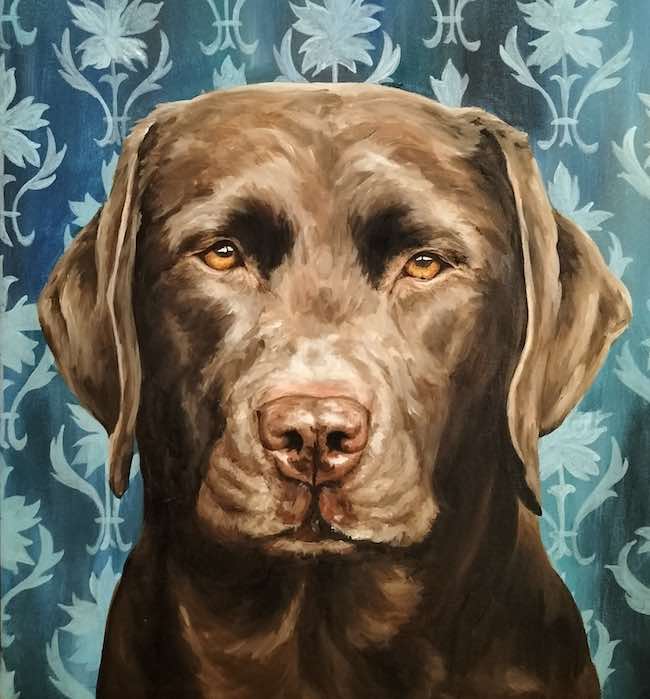
In qualche modo il suo stile si avvicina all’originalità di Kehinde Wiley, artista afroamericano attualmente tra i più quotati, proprio per la tendenza a rendere i personaggi decontestualizzati e immersi in un’atmosfera giocosa, frizzante, a dispetto delle pose solenni; anche lei in un certo modo prende l’impostazione classica del ritratto per poi alleggerirla ed esaltarla con gli sfondi delicati che ricordano carte da parati a volte più delicate, altre più intense, sulla base del carattere degli animali che sceglie di rendere protagonisti.
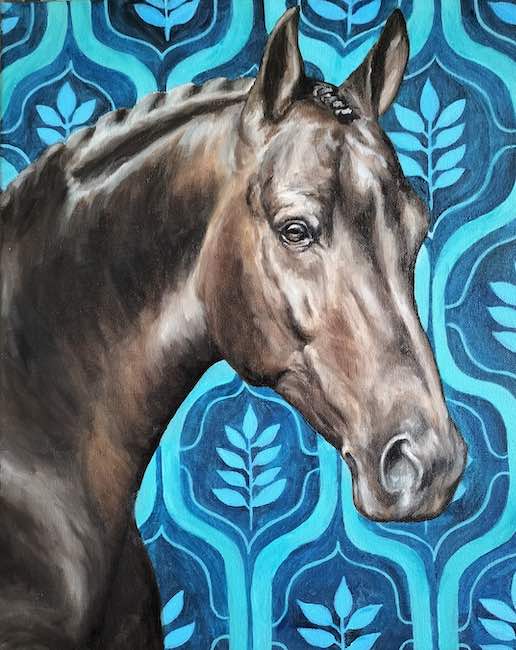
Ecco dunque che in Sospeso nel tempo, il cavallo diviene messaggio di forza, di resilienza, di capacità di rompere i confini, oltrepassare gli ostacoli che contraddistingue la stessa natura equina, suggerendo che tutto ciò che sembra può essere sovvertito se solo si trovasse il coraggio e la determinazione per perseguire il proprio fine anche attendendo il momento giusto, se necessario. È questo invito che sembra celare lo sguardo del cavallo, un suggerimento verso l’osservatore a superare i timori e arginare la fretta attendendo pazientemente il momento giusto, costituito dallo sfondo azzurro che evoca il sogno.
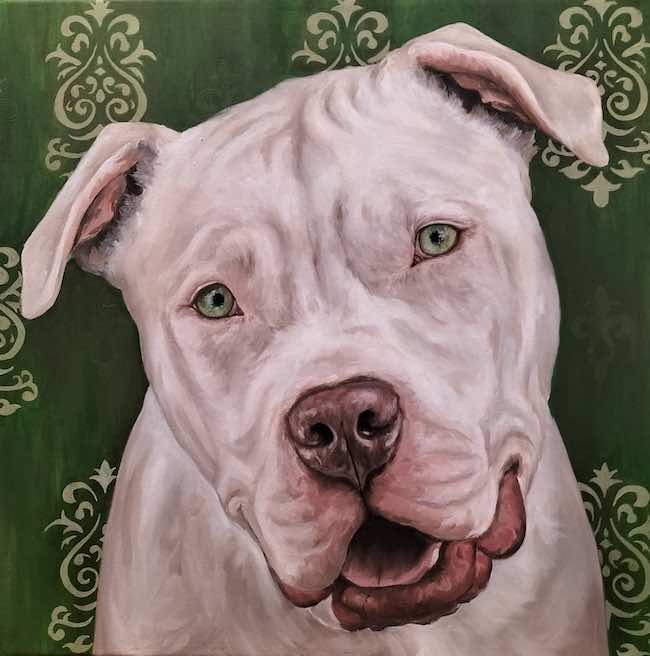
Nell’opera Come a primavera invece il Pitbull sembra scrutare l’artista con curiosità ma anche con la freschezza del cucciolo che ha bisogno di una carezza, come se il suo fosse un invito a non lasciarsi influenzare dalla fama della sua razza bensì andando oltre leggendo la dolcezza dentro i suoi occhi; anche in quest’opera sembra nascondersi la metafora dell’uomo, quel farsi troppo spesso condizionare dai luoghi comuni, dalle generalizzazioni che impediscono di osservare con attenzione chi si ha davanti e inducono a farsi un’idea sbagliata senza mai conoscere in modo più approfondito. In qualche modo il mondo animale somiglia a quello umano pur non conoscendone le complicazioni, le maschere, i sotterfugi a cui spesso l’individuo ricorre per nascondere le proprie debolezze, per sopraffare l’altro, ed è proprio la parte più immediata e naturale che Carlotta Marvasi sembra invitare a ritrovare attraverso le sue coinvolgenti opere; la similitudine nella natura di fondo è evidente tanto quanto le differenze provocate dalla razionalità emergono e dunque è molto più appagante celebrare quella naturalezza che si avvicina al lato migliore dell’uomo. Il tratto dell’artista è preciso nel descrivere i dettagli del pelo degli animali ritratti, tanto quanto l’intensità degli occhi dentro i quali l’osservatore si perde, ne viene attratto al punto che solo in un secondo momento si sofferma sul resto del muso, sulla lucentezza del pelo, sui particolari del colore dello sfondo che sono creati per esaltare le figure raccontate.
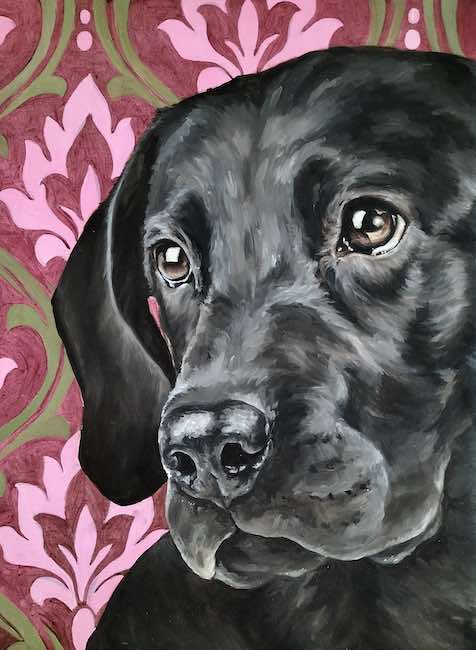
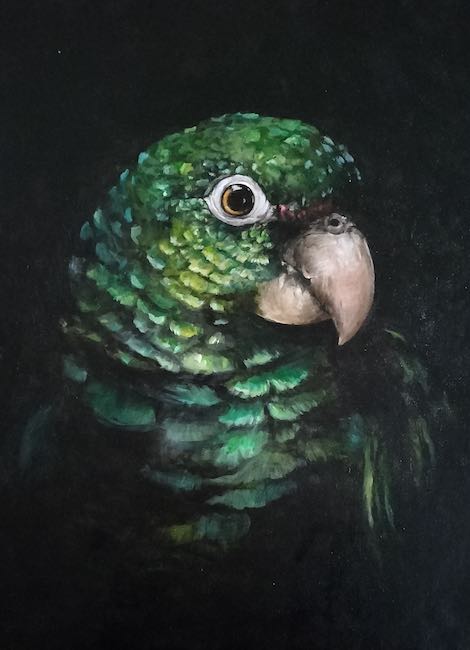
Il rosa è il colore dominante dietro al cucciolo protagonista di Doe eyes in cui emerge lo stupore nei confronti di tutto ciò che è intorno a sé e al tempo stesso la tenera ingenuità di chi osserva le cose con sguardo nuovo, aspettando il momento in cui una coccola tornerà a farlo gioire e sentire al sicuro. Carlotta Marvasi, oltre alla sua nuova impronta artistica che la rende una voce originale nel campo del ritratto di animali, esegue anche opere su commissione a cui finora ha dato un’impronta più metafisica, lasciando emergere i musi degli animali da sfondi neri di grande impatto decontestualizzando la collocazione per permettere all’osservatore di concentrarsi sull’intensità avvolgente degli sguardi o dei colori del soggetto, come nell’opera Allegro con brio di cui è protagonista un pappagallo il cui piumaggio verde brillante sembra palpitare, come fosse sotto un riflettore che ne evidenzia la bellezza e l’atteggiamento quasi vanitoso.
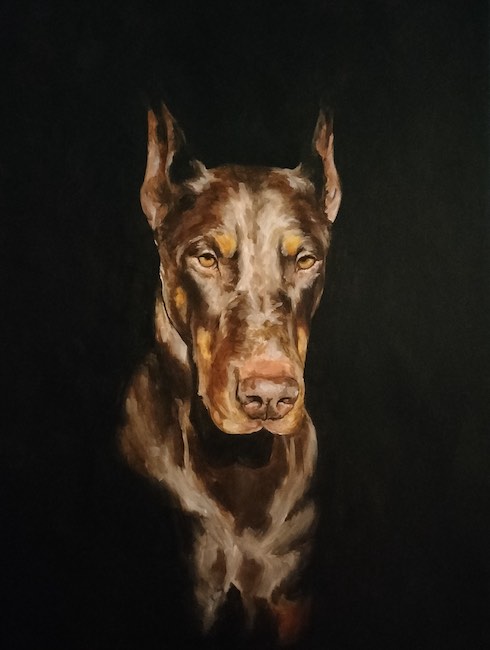
Carlotta Marvasi ha alle spalle un lungo percorso artistico iniziato con le installazioni poi ha studiato come mosaicista, studiando a Ravenna per perfezionare la tecnica, dunque i suoi primi lavori e le sue prime esposizioni sono legate a questa particolare tecnica; successivamente è passata pittura e solo negli ultimi anni ha scelto di avvicinarsi alla tecnica iperrealista attraverso la quale ha potuto unire le sue due grandi passioni, gli animali e la pittura e che le ha permesso di dar vita successivamente al suo originale stile attuale.
CARLOTTA MARVASI-CONTATTI
Email: cmarvasi@gmail.com
Facebook: https://www.facebook.com/profile.php?id=100008456430619
Instagram: https://www.instagram.com/carlottamarvasi_arte/
All the love for animals in Carlotta Marvasi’s Pop Hyperrealism, a new perspective on portraiture
Contemporary art stands as a means of overcoming the limits and boundaries that had characterised the styles of previous centuries, but also as an expression of an evolving society that needs to express and emphasise new values and trends for which creativity becomes an intense and personal voice, a symbol of new concepts and an unprecedented approach to life and everything that is part of it. The artist I am going to tell you about today cannot help but let her great love for the animal world emerge through a fresh and fun style, in which she combines the talent of a classic stroke with colourful and lively backgrounds.
Throughout the history of art, the animal world has always played an important role, for since the days of noble portraits, dogs and cats have been immortalised with their masters as if they were an important part of the family; the dog in particular was the protagonist of artworks by some of the greatest masters of the 15th century, such as Tiziano, who in his Portrait of Charles V exalted the relationship between the sovereign and his pet. In the 17th century, the great Flemish painter Frans Snyders devoted part of his artistic production to portraying animals, especially dogs or hunting scenes, highlighting their expressions and detailing their fur. Despite the fact that at that time the presence of animals in paintings was related to man by defining the economic possibility of having them in the home, there were therefore examples of masters who made dogs, horses, birds the absolute protagonists of high-impact canvases; Velázquez’s Head of a Deer is an example of a true portrait in which the animal world is at the centre of the scene and the deer seems to be conscious of being immortalised, showing an almost human expression.
As the centuries passed and the 20th century approached, many artists interpreted the animal world, each through their own personal style, from Cassius Marcellus Coolidge who in his famous artwork A friend in need imagined a pocker’s table in which the players were dogs of different breeds and whose behaviour and attitudes conformed perfectly to those of humans, to the amusing and colourful stylisation of Keith Haring whose barking dog is closely linked in the common imagination to the artist himself, up to David Hockney, whose love for his two dachshunds led him not only to devote many portraits to them but also to collect his artistic production in an entire volume entitled Dog Days, going against the current with respect to the subjects in vogue in the 1990s, when in the United States in particular, Realism was moving towards the representation of scenes of metropolitan or suburban life as an exaltation of the beauty of cities but also of the loneliness of the human being. And one cannot talk about dogs without mentioning Jeff Koons, who owes his planetary success to this animal. In today’s era, more and more people are taking a puppy into their homes to the point of making it a fundamental part of the family, or to alleviate their emotional loneliness, and so artists who feel akin to the same emotions choose this very genre of painting to express their creativity; from commissioned paintings to those that instead spring from creativity, portraits of man’s best friends have become a true pictorial genre.
The Bolognese artist Carlotta Marvasi, however, chooses not to stop at the hyper-realist representation of the faces of dogs, cats and horses, but delves deeper into the theme, introducing a personal touch that makes her artworks unique, fun and original with a strong Pop style that mixes with the talent of Hyperrealism, by virtue of which she emphasises the details, focusing the whole focus of the canvas on the gazes, livelier, more tender, more curious or distracted according to the personality of the animal she is portraying. The Art Deco backgrounds harmonise with the atmosphere that Marvasi manages to generate around the muzzles and her sensitivity absorbs precisely from the looks and expressions of the mouth the inspiration to tune the perfect tone, the one by virtue of which the portrait comes out, seems to be more alive and at the same time plays down the genre of the portrait, transforming it into a Pop symbol as much as the icons of the cinema and the products symbolising consumerism were with Andy Warhol. In some ways, her style comes close to the originality of Kehinde Wiley, an African-American artist who is currently one of the most popular, precisely because of his tendency to render the characters decontextualised and immersed in a playful, bubbly atmosphere, in spite of the solemn poses; she too in a way takes the classical approach of the portrait and then lightens and enhances it with the delicate backgrounds that are reminiscent of wallpaper, sometimes more delicate, sometimes more intense, based on the character of the animals she chooses to make protagonists.
So in Suspended in Time, the horse becomes a message of strength, of resilience, of the ability to break boundaries, to go beyond the obstacles that characterises equine nature itself, suggesting that everything that seems can be subverted if only one finds the courage and determination to pursue one’s goal, even waiting for the right moment, if necessary. It is this invitation that seems to be concealed in the horse’s gaze, a suggestion to the observer to overcome fears and curb haste by patiently waiting for the right moment, constituted by the blue background that evokes the dream. In the artwork Like in spring, on the other hand, the Pitbull seems to scrutinise the artist with curiosity but also with the freshness of a puppy in need of a caress, as if his was an invitation not to let himself be influenced by the fame of his breed but rather to go beyond it by reading the sweetness in his eyes. In some ways, the animal world resembles the human one without knowing the complications, the masks, the subterfuges that the individual often resorts to in order to hide his own weaknesses, to overpower the other, and it is precisely the more immediate and natural side that Carlotta Marvasi seems to invite us to rediscover through her engaging patinings; the similarity in the underlying nature is as evident as the differences caused by rationality emerge, and so it is much more satisfying to celebrate that naturalness that approaches the better side of man.
The artist’s stroke is precise in describing the details of the coat of the animals portrayed, as much as the intensity of the eyes within which the observer loses himself, is attracted to the point that only later does he linger on the rest of the snout, on the shine of the fur, on the details of the background colour that are created to enhance the figures being told. Pink is the dominant colour behind the puppy protagonist of Doe eyes in which emerges the amazement at everything around him and at the same time the tender naivety of someone who observes things with a new look, waiting for the moment when a cuddle will make him rejoice and feel safe. Carlotta Marvasi, in addition to her new artistic imprint that makes her an original voice in the field of animal portraiture, also executes commissioned paintings to which she has so far given a more metaphysical imprint, letting the snouts of animals emerge from striking black backgrounds by decontextualising the location to allow the observer to focus on the enveloping intensity of the gazes or colours of the subject, as in the artwork Cheerful with brio in which the protagonist is a parrot whose bright green plumage seems to palpitate, as if under a spotlight highlighting its beauty and almost vain attitude. Carlotta Marvasi has a long artistic career behind her, which began with installations and then studied as a mosaicist in Ravenna to perfect the technique, so her first artworks and exhibitions are linked to this particular technique. She then moved to painting and in recent years did she choose to approach the hyperrealist technique through which she was able to unite her two great passions, animals and painting, and which subsequently allowed her to create her original current style.


